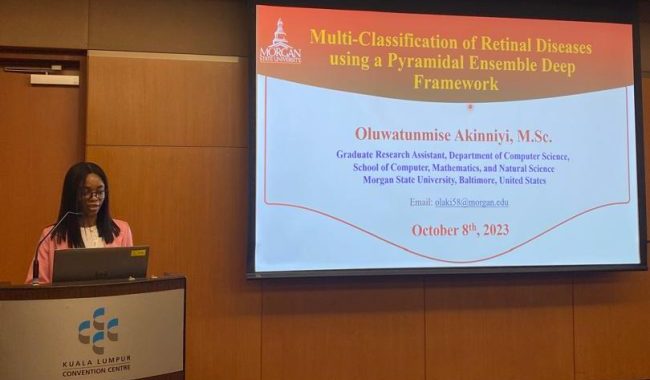In a major step forward for AI-driven medical diagnostics, Oluwatunmise Olamojiba Akinniyi, AIEtm, a leading researcher at Morgan State University, has unveiled a groundbreaking multi-stage classification network that enhances retinal disease diagnosis using optical coherence tomography (OCT) imaging. Speaking at an interactive session with AI specialists and medical researchers, she detailed how this technology improves diagnostic accuracy and early disease detection, potentially transforming ophthalmology and precision medicine.
Her research integrates a multi-scale feature ensemble architecture, demonstrating remarkable accuracy in classifying retinal disorders such as diabetic macular oedema (DME), choroidal neovascularisation (CNV), age-related macular degeneration (AMD), and Drusen. The innovative system employs a scale-adaptive neural network that processes images at multiple resolutions, capturing both global diagnostic features and intricate local details.
At the heart of this framework is a pyramidal architecture powered by DenseNet, which extracts deep, multi-scale features to enhance classification accuracy. Evaluations on two publicly available OCT datasets revealed exceptional performance, with the system achieving 97.78% accuracy in binary classification, 96.83% in three-class classification, and 94.26% in four-class classification in cross-validation experiments. Even more impressively, results on a second dataset yielded 99.69% overall accuracy, with 99.71% sensitivity and 99.87% specificity.
Akinniyi, who is pursuing a Ph.D. in Computer and Electrical Systems Engineering at Morgan State University, emphasised that her proposed network mimics the human perception process—first identifying general abnormalities before categorising specific retinal conditions.
“By leveraging multi-scale adaptation and ensemble learning, the system not only improves diagnostic precision but also facilitates early disease detection, which is critical for timely medical intervention,” she explained.
Her research is supported by the American Society for Engineering Education’s “CyBR-MSI: IRR” sub-award grant and the Centre for Equitable Artificial Intelligence and Machine Learning Systems (CEAMLS) at Morgan State University.
Despite its impressive performance, Akinniyi notes that continued advancements are necessary. Future improvements include expanding testing across diverse retinal datasets and integrating vision transformers to further enhance feature extraction and diagnostic accuracy.
Expanding AI’s Role in Medical Imaging & Computer-Aided Diagnosis
Beyond retinal imaging, Akinniyi’s cutting-edge research extends across multiple medical domains, integrating advanced signal processing techniques for conditions affecting the brain, lungs, and prostate. Her work in RNA in situ hybridisation image processing has transformed data preprocessing, validation, and image segmentation, paving the way for more precise biological and disease analysis.
She has also led breakthrough studies in AI-driven diagnostics for brain tumours, prostate cancer, and breast cancer. Her research leverages deep learning models to tackle health disparities, ensuring more equitable and accurate medical decision-making.
Akinniyi’s expertise in machine learning, deep learning, and biomedical image analysis has positioned her as a key innovator in AI-driven medical diagnostics, with her research gaining traction in leading scientific conferences, including the IEEE International Conference on Image Processing (ICIP).
Her contributions to the field highlight the transformative potential of AI-driven medical imaging, paving the way for more equitable and effective healthcare solutions worldwide.
Bridging AI, Data Science & Real-World Impact
Akinniyi’s commitment to data science extends beyond medical imaging, incorporating AI-powered solutions across multiple disciplines. Her project on RNA in situ hybridisation image processing has significantly improved data validation, segmentation, and biological analysis, reinforcing the importance of AI in computational biology.
Additionally, her prior experience as an HR/Business Data Analyst at CFAO Yamaha Motor Nigeria Limited showcases her ability to apply data analytics and system optimisation techniques across industries. In this role, she leveraged Python, Tableau, and Advanced Excel to analyse HR, marketing, sales, and procurement data, generating actionable insights that enhanced business performance.
This strong foundation in AI, machine learning, and data analytics allows Akinniyi to translate complex data into practical, real-world solutions. By applying the same statistical rigour and computational efficiency to medical imaging, she continues to drive groundbreaking innovations that enhance diagnostic accuracy and equitable healthcare accessibility.
“AI in medical imaging is more than just automation—it is about precision, accessibility, and equitable healthcare,” Akinniyi explains. “By combining AI with advanced medical research, we are not only improving diagnostic accuracy but also making healthcare more accessible for all.”
Her work continues to influence global AI healthcare research, reinforcing her pioneering role in AI-driven diagnostics and precision medicine.






